Chapter 4. Austria
This chapter presents 2014 road safety data for Austria along with provisional data from 2015. It looks at trends in traffic and road safety from the years 1990 to 2014 and road user behavior patterns. This includes data on speed, drink driving, drugs and driving, distracted driving, fatigue and other factors involved in road crashes. The chapter reviews Austria’s road safety strategy and national targets to 2020 and the progress achieved thus far. It also highlights the most recently implemented safety measures.1
The long-term downward trend of road fatalities continued in 2014. The number of road fatalities in 2014 was 430, which is the lowest number since 1961 when safety records began. Fatalities in the cyclist, motorcyclist and pedestrian groups decreased by more than 10% compared to 2013.
Road safety data collection
Definitions applied in Austria
Data included in this report correspond to the consolidated set of police data.
-
Road fatalities refer to deaths within 30 days of the crash.
-
Injury crashes are crashes resulting in at least one injured or killed person.
-
Since 2012 injured persons are subdivided into seriously injured and slightly injured. (Prior to 2012, a third category, “unknown degree of severity”, existed).
-
Seriously injured persons are those suffering an injury resulting in an inability to work or health problems for more than 24 days.
-
Slightly injured are all other injured persons.
-
Data collection
In Austria, crash data are collected by the police. The crash data acquisition process was completely transformed in January 2012 from paper forms to integrated data input including geographic information system (GIS) support. It is believed that this has significantly reduced underreporting rates, especially for less severe road crashes (see resulting increase in the number of injury crashes in Table 4.1 from 2010 to 2013). However, due to the change in collection method, data for injuries and crashes since 2012 cannot be directly compared with previous figures. This does not apply to the number of fatalities.
Injury severity is assessed by the police at the crash scene, with only occasional feedback from hospitals; it is not possible to link police and hospital data directly on the basis of the present data architecture.
Regular estimates for the number of serious injuries are required by the European Commission, based on a Maximum Abbreviated Injury Scale (MAIS) score of 3 or more (MAIS3+). In 2015, for the first time in Austria, this estimate was derived from the International Classification of Diseases-10 (ICD-10) hospital data on road traffic victims.
Most recent safety data
Road crashes in 2015 – provisional data
Based on provisional data, the number of fatalities was 11% higher than in 2014. This increase was predominantly seen among car occupants (+26%), but also pedestrians (+11%) and powered two-wheeler (PTW) riders (+9%).
This relatively bad performance is in part explained by the fact that 2014 had been an extraordinarily good year and had broken all-time records for months June through September. The usual summer high in fatality counts was much less pronounced in 2014 (potential contributors being cool and rainy weather and rising unemployment rates) – whereas 2015 had largely returned to average seasonal values. Initial analysis confirms that exposure on the high level road network was higher in 2015 than in 2014 for the months June through September, especially on weekends.
Road crashes in 2014
The long-term downward trend of road fatalities continued in 2014. The number of road fatalities declined by 5.5% in 2014 to 430, which is the lowest number since 1961 when safety records began. This development holds true for most road user groups in 2014. Since 2013, motorcycle fatalities are the second largest group of road casualties.
In 2014, the police recorded 37 957 injury crashes (-1.4 % compared to 2013). Since the increase observed in 2012 when the crash data collection method was changed, the trend has been downward. However, as this trend is relatively short, the observed reduction has to be interpreted with caution.
Trends in traffic and road safety (1990-2014)
Traffic
Since 1990, the number of vehicles has increased by 52.5% and the number of kilometres driven has increased by 65% (2013 data). Until 2008, the average yearly increase in kilometres driven was nearly 3%; in 2009, the trend shifted downward and growth since then has been about 1.1% annually. However, 2014 saw an increase of nearly 3%, mostly accounted for by increased private car use.
Road safety
Crashes and casualties
Between 1990 and 2014, the number of road fatalities decreased by 72%. More recently (2000 to 2014), the number of fatalities decreased by 56%. A rise of crash figures in 2012 was artificially induced by the new data collection methodology. As a result, injury crash counts for 2012 and later cannot be compared to previous years.
The substantial decline in road mortality since 1990 was marked by the implementation of the first two integrated road safety programmes in Austria incorporating a variety of measures including:
-
second phase education for novice drivers after granting the driving licence
-
automatic section control of average speeds along stretches of motorways and rural roads
-
awareness campaigns in such areas as seat belt and child restraint use, alcohol and child safety
-
large-scale roadside testing for alcohol using alcohol screening devices
-
penalty point system.
Rates
The road death rate per 100 000 inhabitants has decreased by 75% since 1990, while the number of vehicles per 1 000 inhabitants has increased by 37%.
Analysis of seriously injured data
In 2014 and 2015, KfV carried out a feasibility study on MAIS3+ assessment on behalf of the Austrian Transport Ministry (BMVIT). The study covered two methods of estimating the number of serious road injuries:
-
application of a (hospital data based) correction factor to the police reported number of serious injuries
-
use of hospital data alone to arrive at an estimate for serious injuries.
The latter method was selected for further use. In late 2015, for the first time, the number of MAIS3+ injuries was estimated, totalling 1 410 for the year 2014. For the same year, the number of fatalities was 430, resulting in a ratio of 3.28 between serious injuries and fatalities.
The accuracy of the estimation procedure may be substantially influenced by data quality and the accuracy of the Hospital Discharge Register.
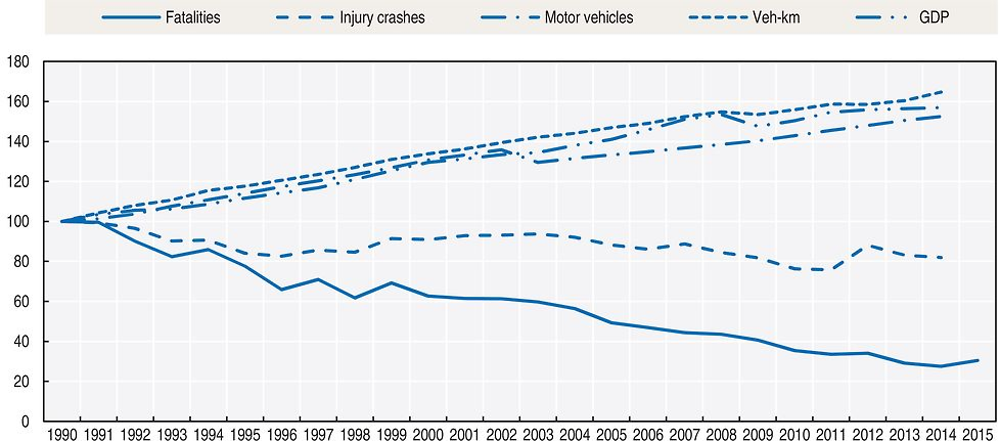
Note: A direct comparison of data on injury crashes, or injured road users, with data recorded before 2012 is not possible.
Source: World Bank for growth domestic product (constant prices).
Road safety by user group
Since 1990, all road users in Austria have benefited from improvements in road safety. By 2014, there was a 79% reduction in fatalities among the largest group, car occupants. Among the second largest group, pedestrians, by 2012 fatalities were reduced by 73% with a further substantial 15% reduction between 2013 and 2014. This positive development is contrasted by an increase since 2010 in motorcycle fatalities (10%), making this group the second largest in terms of fatalities following car occupants, which represent 44% of all fatalities.
Cycling popularity is increasing in Austria and municipalities are providing additional and safer cycling infrastructures. The cyclists group accounted for 10% of all fatalities in 2014.
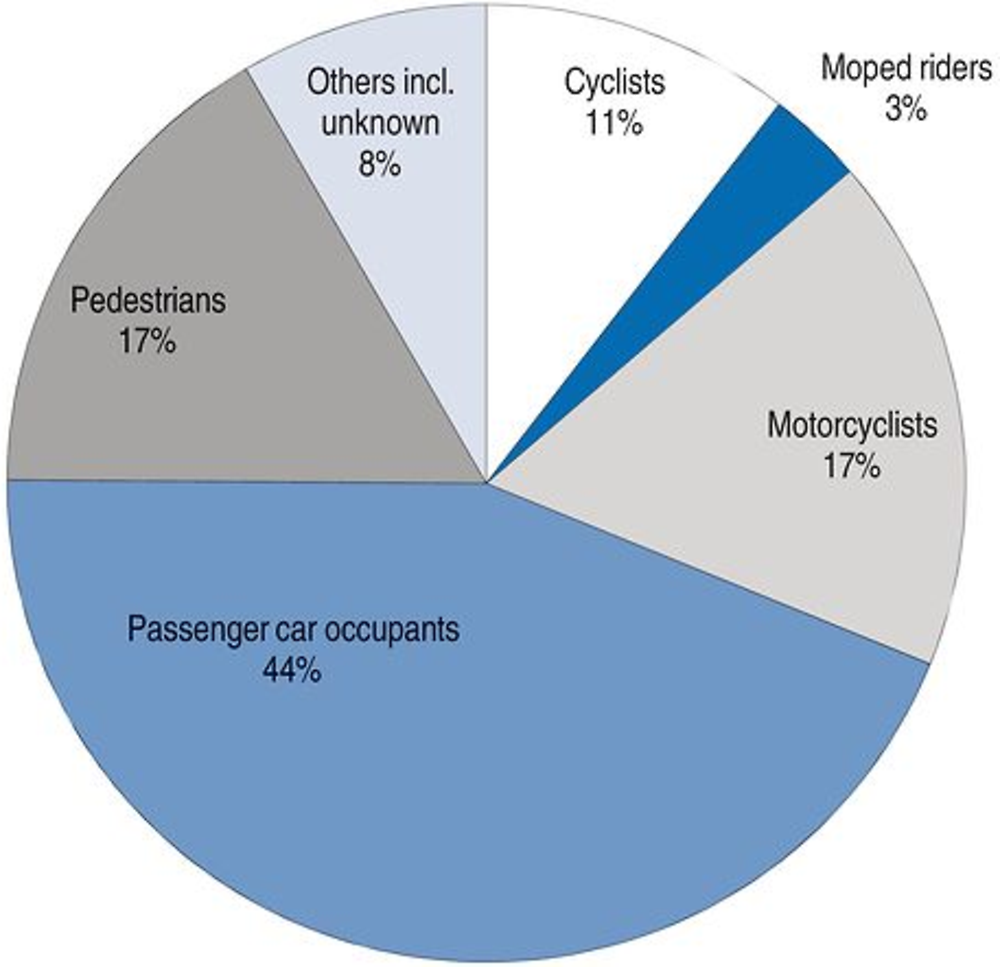
Road safety by age group
Since 1990, the reduction in fatalities has benefited all age groups. For most groups, their fatalities decreased by more than 70%. Historically, young people represent a high-risk group in road safety. In 1990, the highest number of fatalities per 100 000 inhabitants was recorded for persons 18-20 years old (59), followed by the 21-24 years old group (35). In 2014 this rate decreased to 9 and 8 respectively and has even gone below the rate for the other groups (7 for 65+, 6 for 15-17, 5 for 25-64, and 1 for 0-14).
Excepting the lower age groups (under 15 years old), where fatalities are too low for a meaningful interpretation, the highest rate of decrease in fatalities, 19%, was for the 65+ group between 2013 and 2014, while fatalities for the other groups slightly increased or remain unchanged.
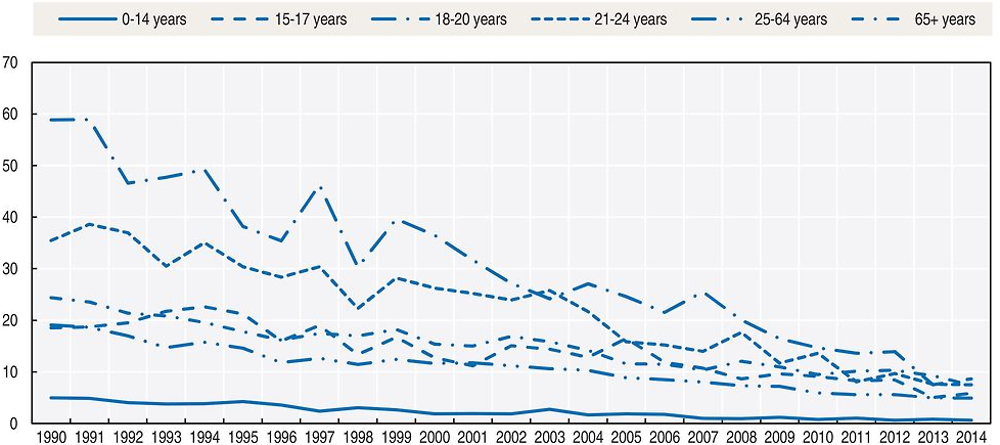
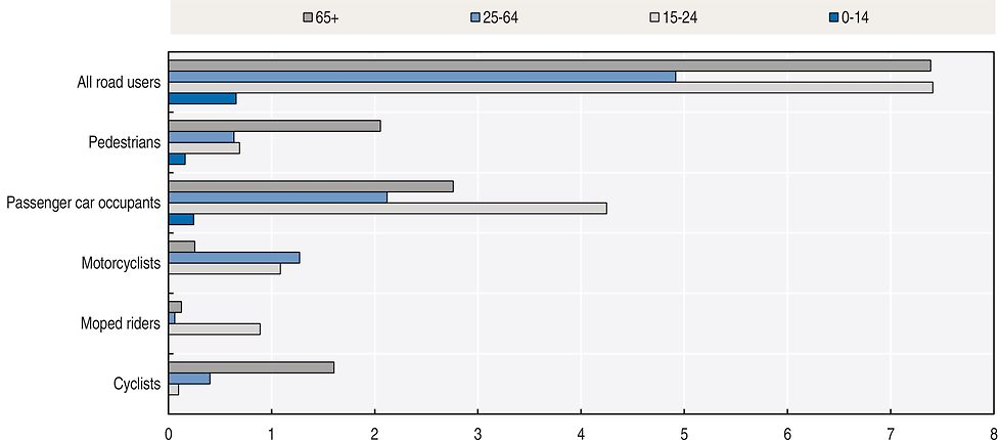
Road safety by road type
In 1990, 65% of fatalities occurred on rural roads, 25% in urban areas and 10% on motorways. While the overall fatalities have been reduced by 72% since 1990, fatalities on motorways decreased by the highest rate (77%) followed by 73% on rural roads and 69% inside urban areas.
In 2014, 63% of fatalities occurred on rural roads, 29% in urban areas and 9% on motorways. Compared with the previous year’s statistics, the fatalities inside urban areas and on motorways increased by 7% and 9% respectively, but those on rural roads (the largest group) decreased by 12%, which contributed to the overall decrease.
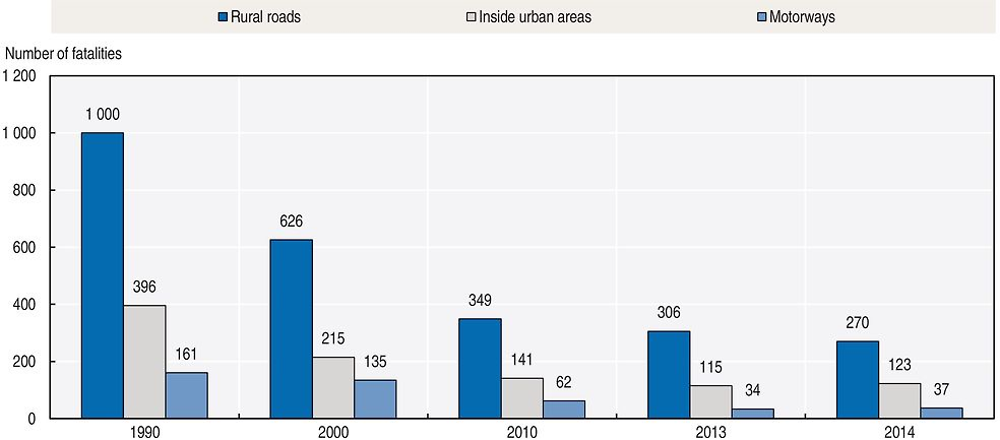
Economic costs of traffic crashes
Traffic crashes represent a very significant cost for Austrian society, estimated at around EUR 10 billion (about 3.4% of Gross Domestic Product).
There are no regular updates on the economic costs of traffic crashes in Austria, but according to a recent study (Herry et al., 2013), the costs of human suffering make up almost half of the crash costs (48% using the “willingness to pay” approach), while the most important other costs are material damage (25%), loss in achievement potential (15% using human capital approach), insurance administration (7%) and legal costs (2%).
Recent trends in road user behaviour
Speed
Speed, and especially inappropriate speed, is one of the main causes of crashes in Austria. According to a police assessment in 2014, 14% of all injury crashes and 26% of all road fatalities were caused by inadequate speed.
Due to restrictions in manpower, increases in speed surveillance by traffic police cannot be expected in the future, but automatic speed enforcement including section controls will be further developed. The table below summarises the main speed limits in Austria.
Drink driving
To define drink driving crashes, Austria uses the definition recommended by the European Union project SafetyNet: any crash in which any active participant was found with a blood alcohol level above the legal limit.
The maximum permissible blood alcohol content (BAC) level for drivers in Austria has been 0.5 g/l since 1998. The level is 0.1 g/l for moped drivers younger than 20 years, novice drivers (holding a licence for less than two years), drivers of trucks over 7.5 tonnes and drivers of buses with more than nine seats.
Since 2002, every driver involved in an injury crash is tested for alcohol. However, it is not permitted in Austria to test a corpse or an unconscious person (unless the prosecutor requires it). Therefore the number of unreported cases is believed to be substantial.
In 2014 there were 2 213 drink-driving crashes (-6% compared to 2013) with 2 890 injured persons (-6%) and 32 fatalities (+3%). The share of fatalities in crashes involving an alcohol-intoxicated person rose from 6.8% in 2013 to 7.4% in 2014.
Drink driving remains a predominantly male problem. However, the share of drunk females in alcohol-related crashes has been on a steady increase since 2000 (8%) and reaching 16% in 2014.
Drugs and driving
Austrian regulations provide no specific thresholds for drug concentrations. It is forbidden to drive or ride a motor vehicle while under the influence of drugs.
Little is currently known about the prevalence of drugs as a causal factor in accidents. According to a subjective assessment of the Austrian police, in 2014, 4.2% of all injury crashes and 3.1% of all road fatalities were caused by impairment due to alcohol and illicit or pharmaceutical drugs.
Distraction
In 2014, about 38% of all road traffic crashes and 31% of all road fatalities were attributed to inattentiveness or distraction as the main causes for the crash.
In Austria, it is not allowed to drive while using a hand-held mobile phone. However, the use of hands-free devices is tolerated. The use of hand-held mobile phones while cycling was banned in 2013.
A legislative proposal was presented in 2015 with the aim of prohibiting hand-held mobile phone use during driving, now including texting, dialling, social media etc., with the exception of navigation.
Sleepiness and fatigue
The share of fatigue as a causal factor in crashes is especially challenging to detect. According to the Austrian Statistics Bureau and based on police assessment, in 2014, 1.5% of all injury crashes and 3.1% of all road fatalities were caused by drowsiness in drivers. The real figures may be significantly higher.
Seat belts and helmets
Seat belt wearing has been compulsory in Austria since 1984 in front seats and from 1990 for rear seats. The belt wearing rate on front seats has been steadily increasing and was around 95% in 2014, whereas rear seat belts are still used by only 77% of car occupants.
The use of dedicated child restraint devices has been mandatory in Austria since 1994 for children under 14 years of age or less than 150 cm tall.
The share of fatally injured car occupants that were not using a seat belt has gone down from about 50% in 2000 to 34% in 2014.
Helmets are compulsory on all powered two-wheelers. The helmet-wearing rate by riders of powered two-wheelers is not surveyed regularly, but it is believed to be at practically 100%.
Since June 2011, bicycle helmets have been compulsory for children up to 12 years of age.
National road safety strategies and targets
Organisation of road safety
Primary responsibility for road safety in Austria lies with the Federal Ministry for Transport, Innovation and Technology (BMVIT). BMVIT co-operates with the Federal Ministry of the Interior (BM.I) and other government ministries, regional and local authorities, interest groups, chambers of commerce and industry, trade and labour associations and road safety organisations through the Road Safety Programme.
The Road Safety Advisory Council, established at BMVIT, serves as the institutional platform for partners in the Road Safety Programme. It was established in 2006 as the forum for decision makers in matters relating to road safety and, in particular, for the preparation, ongoing evaluation and development of road safety programmes for all modes of transport. Members are transport spokespersons for the parliamentary political parties, representatives of government ministries, local and regional authorities, automobile clubs, chambers of commerce and industry, trade and labour associations, interest groups and research institutions.
The Austrian Road Safety Fund, also established at BMVIT, was set up with the aim of promoting and furthering road safety. The Road Safety Fund is funded with revenues of personalised vehicle number plates. The Road Safety Fund plays a key role in financing road safety related research and activities relating to the Road Safety Programme. Funding priorities are aligned to Road Safety Programme targets.
Road safety strategy for 2011-20
Despite significant progress in the last decade, Austrian road safety figures are still only average compared to the European Union as whole and below average for the EU 15 countries. The Road Safety Programme 2011-2020 aims at “making Austria one of the five safest countries in Europe”. It is based on the Safe System approach and has an increased focus on reducing the number of serious injuries on Austrian roads. The Programme features 17 main fields of action.
Road safety targets
-
-50% fatalities by 2020, based on the average for the years 2008-10 (Interim target: -25% by 2015)
-
-40% serious injuries by 2020, based on the average for the years 2008-10 (Interim target: -20% by 2015)
-
-20% injury crashes by 2020, based on the average for the years 2008-10 (Interim targets: -10% by 2015).
The targets are based on the EU fatality reduction target as well as the European Transport Safety Council’s proposal for a serious injury reduction target.
Monitoring targets
To ensure the Road Safety Programme is successfully implemented, the Road Safety Advisory Council provides support in all 17 fields of action throughout the duration of the programme. It gathers and analyses available annual crash statistics, behaviour parameters and safety indicators. Based on this information, measures are adjusted as required to accommodate changes in road behaviour and crashes.
The interim fatality target for the year 2015 was reached in 2013 but preliminary figures indicate an increase slightly above target value for 2015.
The Annual Report 2014 by the Federal Ministry for Transport, Innovation and Technology (BMVIT, 2014a) provides the most recent overview of the implementation status of the Road Safety Programme and therefore serves as an ongoing programme evaluation tool.
A mid-term evaluation of the Programme was carried out in 2015 jointly by BMVIT and members of the Road Safety Advisory Council, eventually leading to an updated version of the Programme for the 2016-20 term.
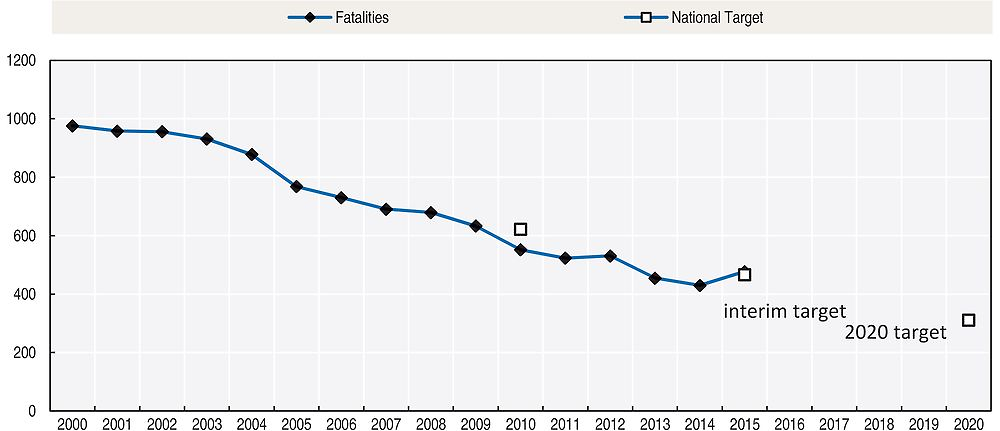
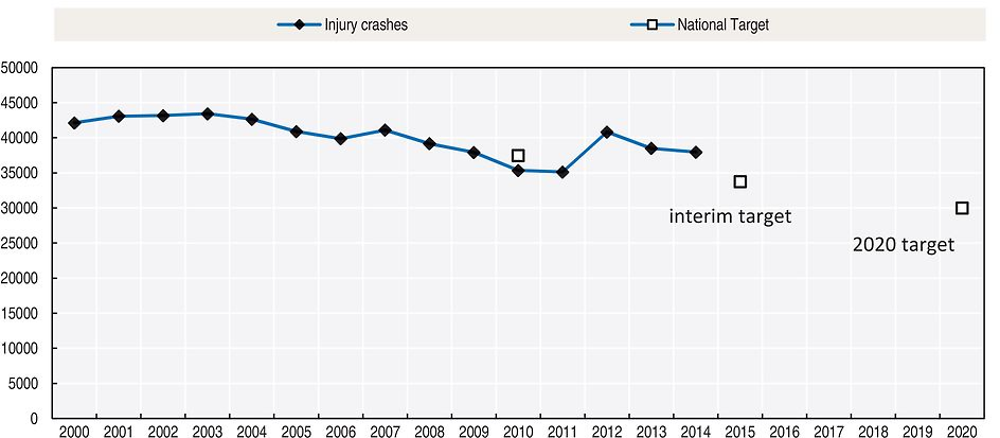
← 1. Crash data acquisition process changed in 2012.
Recent safety measures (2013-16)
Road safety management
-
An Austria-wide mobility survey was launched in 2013. This marks the start of regular nationwide mobility surveys.
-
A law on a Risk Assessment System for transport companies (implementation of Directive 2006/22/EC) was passed in 2013.
-
An updated version of the Austrian Road Safety Programme was published in 2016 (BMVIT 2014b)
Road users
Driving license
-
A late starter motorcycle driving licence (for age group 39+) was introduced in 2014, featuring new modules on risk competence and practical handling of heavy bikes.
-
A risk competence course for all driving instructors of A-categories was introduced in 2015.
-
In the general motorcycle second phase rider training (post-licence, category A), risk identification training and a feedback driving session were introduced in 2013.
Distraction
-
A legislative proposal was presented in 2015 with the aim of prohibiting hand-held mobile phone use during driving, now including texting, dialling, social media etc., with the exception of navigation.
Driving under the influence
-
A maximum BAC level of 0.1 g/l for non-commercial school transport will be introduced (legislative proposal presented in 2015).
Protective equipment for motorcyclists
-
The Supreme Court ruled that motorcycle riders not wearing appropriate protective clothing (in addition to a safety helmet) will not receive full compensation in case of an accident.
Infrastructure
-
In 2014, trucks > 7.5 t were banned from using fast lanes on motorways with three or more lanes.
-
The Encounter Zone (“Begegnungszone”) was introduced into the Highway Code in 2013, with a speed limit of 20 km/h. All traffic is allowed on the carriageway, including walking and roller-skating.
-
Cycle Roads (“Fahrradstraße”) were introduced into the Highway Code in 2013. On these roads, powered vehicles have restricted access.
-
Flexibility in the compulsory use of cycling paths was introduced in 2013. Authorities are now entitled to decide whether a specific cycling path is to be used by cyclists voluntarily or mandatorily.
Vehicles
-
Winter tyres are obligatory for four-wheeled light vehicles (“Microcars”) since 2013.
-
An Austria-wide database on vehicle roadworthiness certificates has been established.
Recent and ongoing research
The Austrian Road Safety Fund (RSF) has been issuing thematic calls for tenders since 2010. The respective themes are defined by BMVIT in line with Road Safety Programme goals and current accident trends. For all RSF projects, reports are available on the BMVIT website (in German, with English abstracts). Some examples are listed here:
-
Mobilitätsverhalten und Unfallgeschehen von Kindern auf Schul- und Freizeitwegen (children’s modal choice and accidents on their school and leisure time trips) www.bmvit.gv.at/bmvit/verkehr/strasse/sicherheit/fonds/vsf/46_mukis.html.
-
Handbuch zur Durchführung von RSI (Road Safety Inspection Handbook) www.bmvit.gv.at/bmvit/verkehr/strasse/sicherheit/fonds/vsf/38_ris.html.
-
Highlight: Wahrnehmbarkeitssteigerung im Straßenverkehr (Improving perceptibility through adequate road lighting) www.bmvit.gv.at/bmvit/verkehr/strasse/sicherheit/fonds/vsf/39_ highlight.html.
-
Überprüfung und Verbesserung der Verkehrssicherheit im Schulumfeld (Safety assessment and improvement around schools) www.bmvit.gv.at/bmvit/verkehr/strasse/sicherheit/fonds/vsf/41_schulumfeld.html.
-
Optimierte Anordnung von Rumpelmarkierungen unter Berücksichtigung von Lärmemission mit Beurteilung der Sicherheitswirkung (Use of rumble strips taking account of noise emissions and assessment of safety impacts) www.bmvit.gv.at/bmvit/verkehr/strasse/sicherheit/fonds/vsf/43_rumpelmarkierungen.html.
-
Optimaler Schutz vor Kopfverletzungen durch verbesserte Testmethoden von Kinder-Fahrradhelmen (Better prevention of head injuries through improved test methods for cycle helmets for children) www.bmvit.gv.at/bmvit/verkehr/strasse/sicherheit/fonds/vsf/44_clevererhelm.html.
References
BMVIT (2014a), Road Safety in Austria – Annual Report 2014, Federal Ministry for Transport, Innovation and Technology, Vienna, www.bmvit.gv.at/bmvit/en/service/publications/transport/downloads/roadsafety_report2014.pdf.
BMVIT (2014b), Austrian Road Safety Programme 2011-2020, updated version for 2016-2020, Federal Ministry for Transport, Innovation and Technology, Vienna, www.bmvit.gv.at/bmvit/en/verkehr/roads/safety/publications/index.html.
Herry, M. et al. (2013), Studie im Auftrag des VSF/bmvit: Unfallkostenrechnung Straße 2012 unter Berücksichtigung des menschlichen Leids, Federal Ministry for Transport, Innovation and Technology, Vienna.
Websites
-
Austrian Ministry for Transport, Innovation and Technology : www.bmvit.gv.at.
-
Austrian Road Safety Board (KFV): www.kfv.at.
-
Statistik Austria: www.statistik.at/web_en/statistics/transport/road/road_traffic_accidents/index.html.
-
Information site on child safety in cars: www.autokindersitz.at/content/index.php.
-
Automobile, Motorcycle and Bicyclists Club Austria: www.arboe.at.
-
Austrian Automobile, Motorcycle and Touring Club: www.oeamtc.at.
← 1. All data stem from KFV (Kuratorium für Verkehrssicherheit, based on disaggregated police data provided by Statistik Austria) and IRTAD unless otherwise noted. For more information please contact: [email protected].
